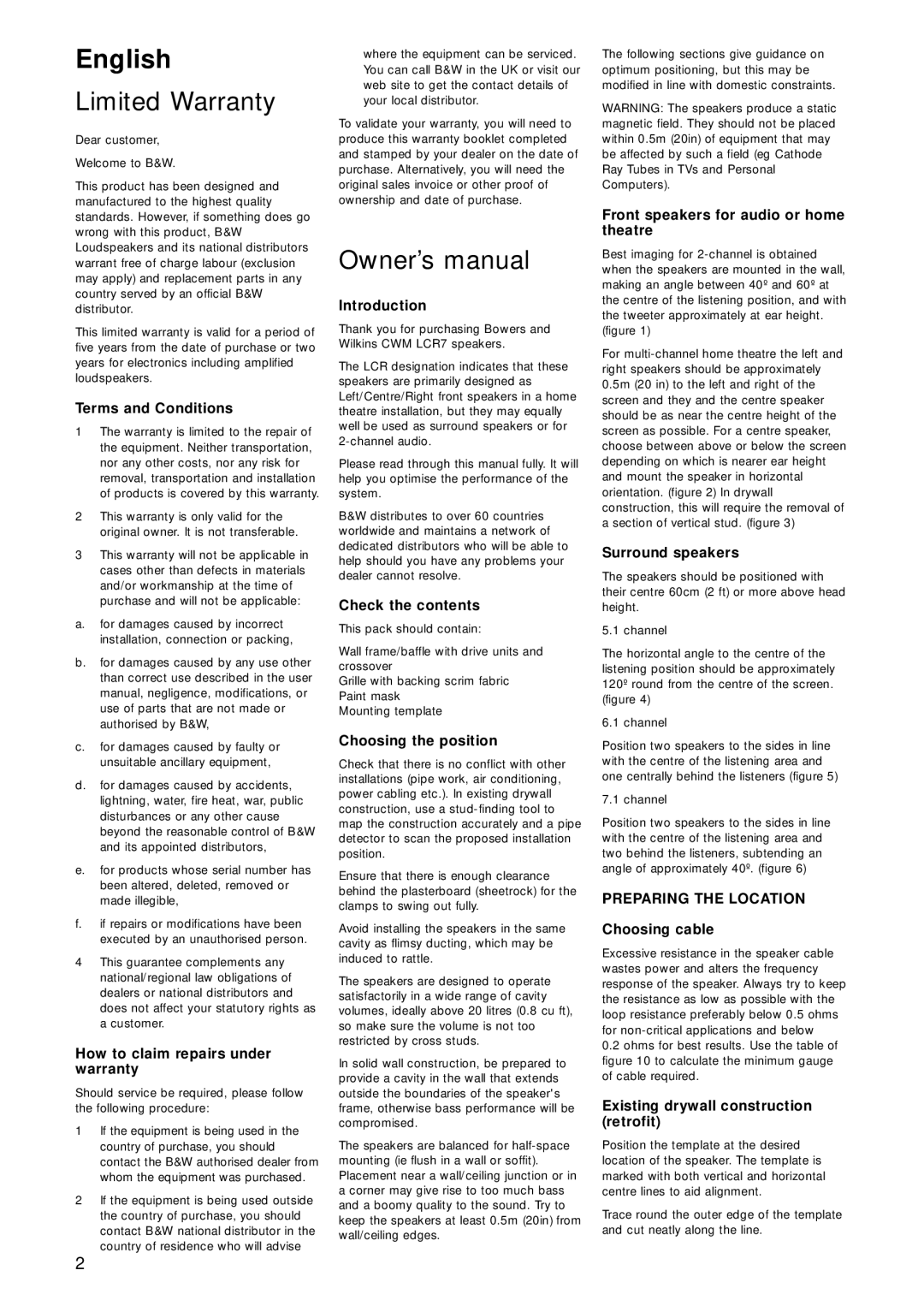English
Limited Warranty
Dear customer,
Welcome to B&W.
This product has been designed and manufactured to the highest quality standards. However, if something does go wrong with this product, B&W Loudspeakers and its national distributors warrant free of charge labour (exclusion may apply) and replacement parts in any country served by an official B&W distributor.
This limited warranty is valid for a period of five years from the date of purchase or two years for electronics including amplified loudspeakers.
Terms and Conditions
1The warranty is limited to the repair of the equipment. Neither transportation, nor any other costs, nor any risk for removal, transportation and installation of products is covered by this warranty.
2This warranty is only valid for the original owner. It is not transferable.
3This warranty will not be applicable in cases other than defects in materials and/or workmanship at the time of purchase and will not be applicable:
a.for damages caused by incorrect installation, connection or packing,
b.for damages caused by any use other than correct use described in the user manual, negligence, modifications, or use of parts that are not made or authorised by B&W,
c.for damages caused by faulty or unsuitable ancillary equipment,
d.for damages caused by accidents, lightning, water, fire heat, war, public disturbances or any other cause beyond the reasonable control of B&W and its appointed distributors,
e.for products whose serial number has been altered, deleted, removed or made illegible,
f.if repairs or modifications have been executed by an unauthorised person.
4This guarantee complements any national/regional law obligations of dealers or national distributors and does not affect your statutory rights as a customer.
How to claim repairs under warranty
Should service be required, please follow the following procedure:
1If the equipment is being used in the country of purchase, you should contact the B&W authorised dealer from whom the equipment was purchased.
2If the equipment is being used outside the country of purchase, you should contact B&W national distributor in the country of residence who will advise
where the equipment can be serviced. You can call B&W in the UK or visit our web site to get the contact details of your local distributor.
To validate your warranty, you will need to produce this warranty booklet completed and stamped by your dealer on the date of purchase. Alternatively, you will need the original sales invoice or other proof of ownership and date of purchase.
Owner’s manual
Introduction
Thank you for purchasing Bowers and Wilkins CWM LCR7 speakers.
The LCR designation indicates that these speakers are primarily designed as Left/Centre/Right front speakers in a home theatre installation, but they may equally well be used as surround speakers or for
Please read through this manual fully. It will help you optimise the performance of the system.
B&W distributes to over 60 countries worldwide and maintains a network of dedicated distributors who will be able to help should you have any problems your dealer cannot resolve.
Check the contents
This pack should contain:
Wall frame/baffle with drive units and crossover
Grille with backing scrim fabric Paint mask
Mounting template
Choosing the position
Check that there is no conflict with other installations (pipe work, air conditioning, power cabling etc.). In existing drywall construction, use a
Ensure that there is enough clearance behind the plasterboard (sheetrock) for the clamps to swing out fully.
Avoid installing the speakers in the same cavity as flimsy ducting, which may be induced to rattle.
The speakers are designed to operate satisfactorily in a wide range of cavity volumes, ideally above 20 litres (0.8 cu ft), so make sure the volume is not too restricted by cross studs.
In solid wall construction, be prepared to provide a cavity in the wall that extends outside the boundaries of the speaker's frame, otherwise bass performance will be compromised.
The speakers are balanced for
The following sections give guidance on optimum positioning, but this may be modified in line with domestic constraints.
WARNING: The speakers produce a static magnetic field. They should not be placed within 0.5m (20in) of equipment that may be affected by such a field (eg Cathode Ray Tubes in TVs and Personal Computers).
Front speakers for audio or home theatre
Best imaging for
For
Surround speakers
The speakers should be positioned with their centre 60cm (2 ft) or more above head height.
5.1 channel
The horizontal angle to the centre of the listening position should be approximately 120º round from the centre of the screen. (figure 4)
6.1 channel
Position two speakers to the sides in line with the centre of the listening area and one centrally behind the listeners (figure 5)
7.1 channel
Position two speakers to the sides in line with the centre of the listening area and two behind the listeners, subtending an angle of approximately 40º. (figure 6)
PREPARING THE LOCATION
Choosing cable
Excessive resistance in the speaker cable wastes power and alters the frequency response of the speaker. Always try to keep the resistance as low as possible with the loop resistance preferably below 0.5 ohms for
0.2ohms for best results. Use the table of figure 10 to calculate the minimum gauge of cable required.
Existing drywall construction (retrofit)
Position the template at the desired location of the speaker. The template is marked with both vertical and horizontal centre lines to aid alignment.
Trace round the outer edge of the template and cut neatly along the line.
2
